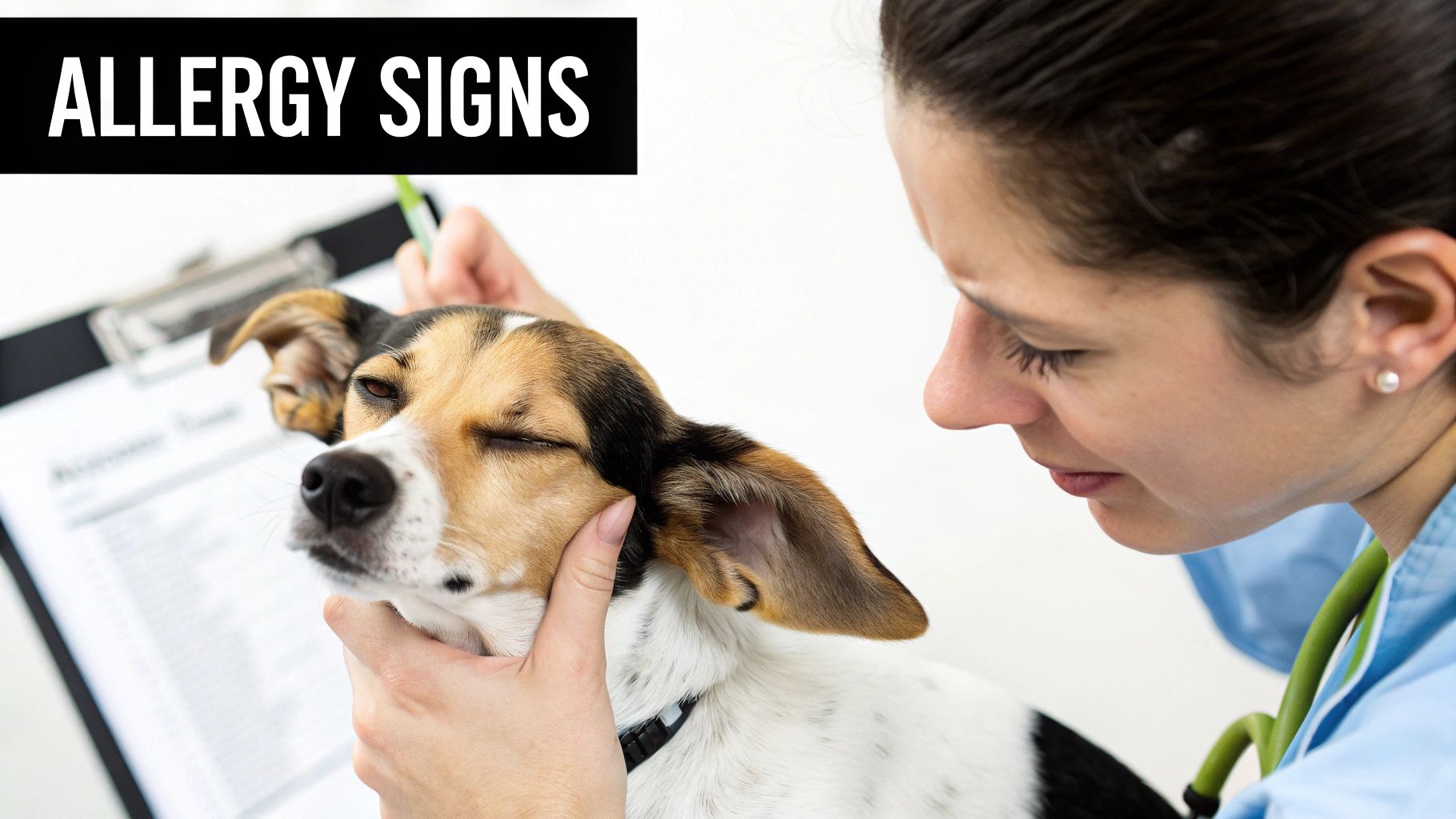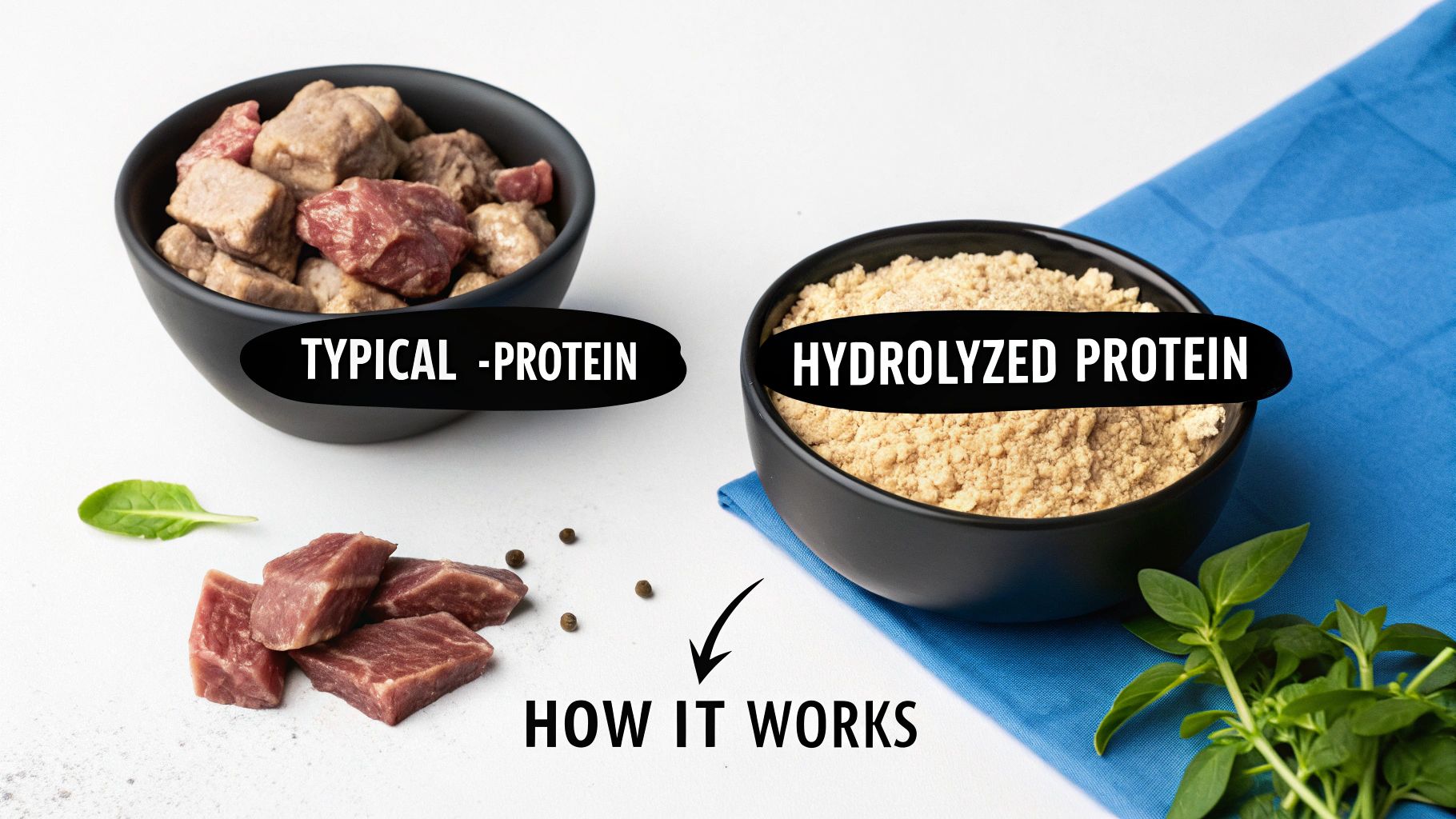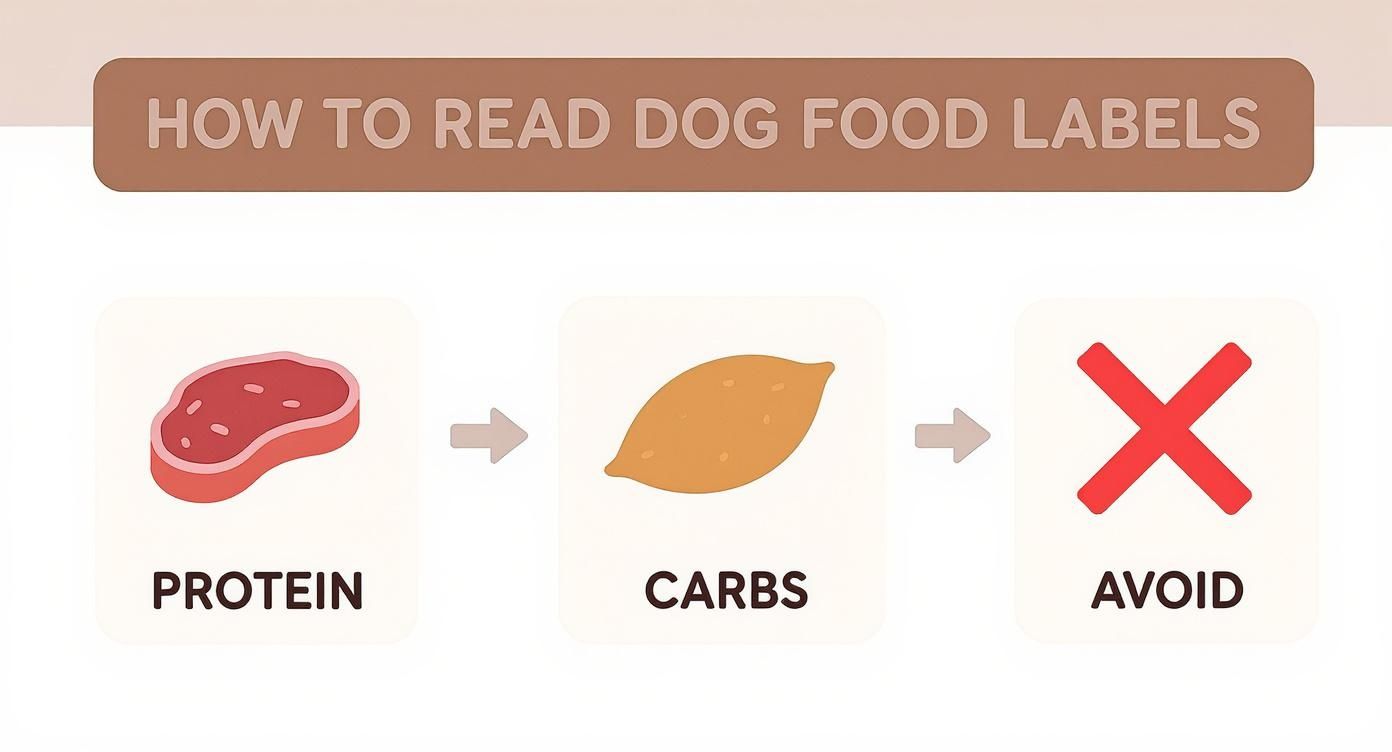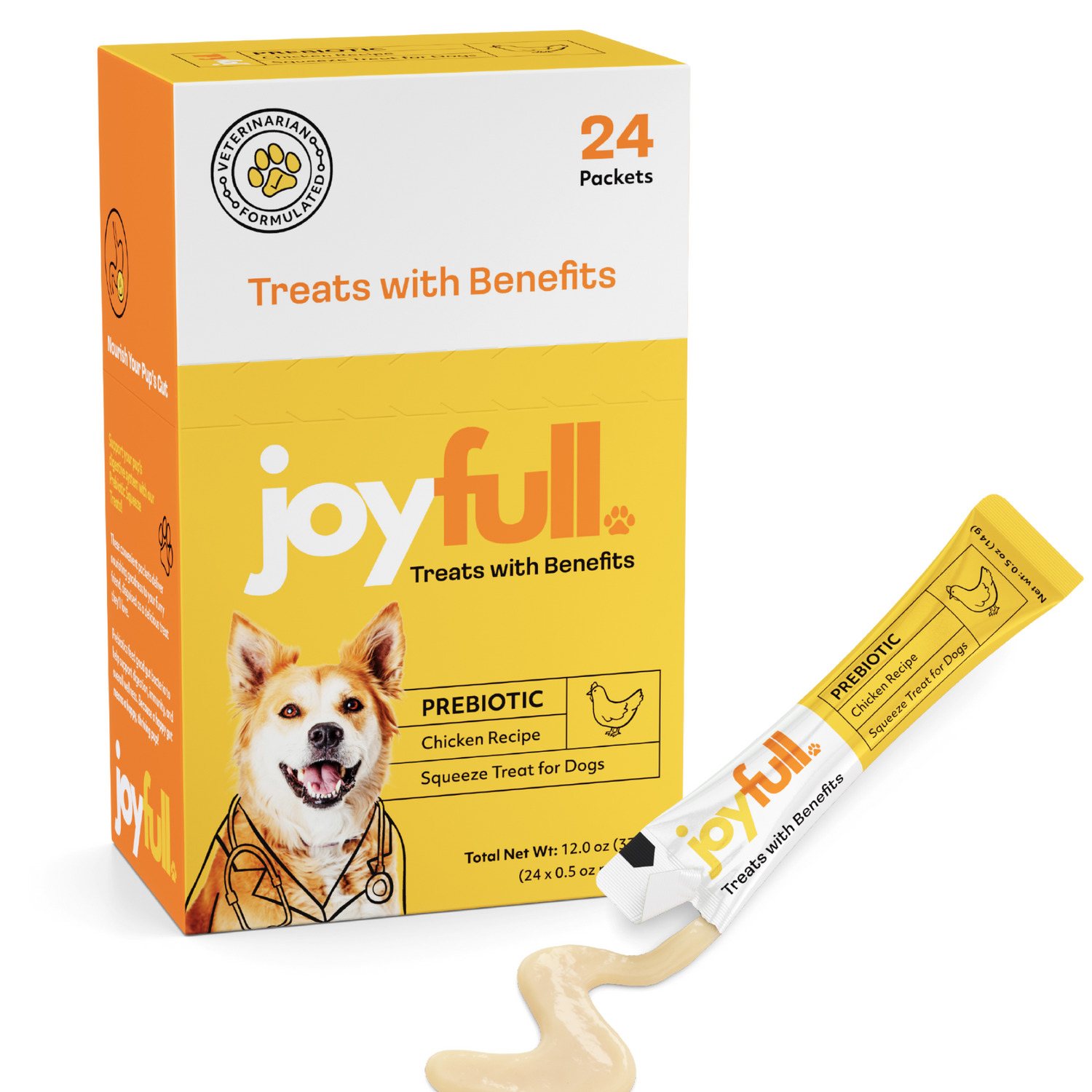
Best Hypoallergenic Dog Food Brands Reviewed
When you see your dog constantly scratching and clearly uncomfortable, finding the right food feels like an emergency. Vets often point owners toward some of the best hypoallergenic dog food brands like Royal Canin, Hill's Prescription Diet, and specialized formulas from brands such as Meals For Mutts that build their recipes around novel or hydrolyzed proteins. These aren't just regular dog foods; they're specifically designed to give your pet real relief from the misery of food allergies.
Finding the Right Food for Your Allergic Dog
It's heartbreaking to watch a furry family member suffer from relentless itching, obsessive paw licking, or chronic tummy troubles. If you've started to suspect a food allergy is the root cause, you’re on the right track to finding a solution. This guide will help you navigate the options and choose a diet that can finally bring some peace and comfort back into your dog's life.

So, what does "hypoallergenic" actually mean? In simple terms, it just means the food is less likely to cause an allergic reaction. Think of it as a stealth mode for your dog's diet. Many standard dog foods use common proteins like chicken or beef, which a sensitive dog's immune system can mistakenly identify as a threat, launching an all-out attack that results in those frustrating allergy symptoms.
Hypoallergenic diets sidestep this problem. They cleverly swap out the usual culprits for ingredients that don't trigger the immune system's alarm bells. This gives your dog's body a much-needed rest from the constant inflammation.
Understanding Hypoallergenic Strategies
How exactly do these special diets pull this off? It usually comes down to one of two clever strategies:
- Novel Proteins: This approach introduces a protein source your dog has probably never encountered before. We're talking about ingredients like duck, kangaroo, or venison. Because their immune system has no history with these proteins, it's far less likely to overreact.
- Hydrolyzed Proteins: This is a more scientific method. It takes a common protein source and uses water to break it down into incredibly tiny fragments. These pieces are so small that the immune system simply doesn't recognize them as an allergen, effectively preventing a reaction before it can even start.
Figuring out which strategy is best for your dog is the first major step toward a happier, itch-free life. To help you get started, here's a quick look at some of the top brands and how they approach the problem.
Top Hypoallergenic Dog Food Brands at a Glance
This table provides a snapshot of leading brands, highlighting their protein sources and what types of allergies they are best suited for. It's a great starting point for identifying which formulas might be the right fit for your dog's specific needs.
| Brand | Primary Protein Type | Best For | Key Feature |
|---|---|---|---|
| Royal Canin | Hydrolyzed Proteins | Severe or multiple allergies | Vet-recommended for diagnostic trials |
| Hill's Prescription Diet | Novel & Hydrolyzed Proteins | Skin and digestive sensitivities | Patented single-molecule protein source |
| Meals For Mutts | Novel Proteins | Mild to moderate sensitivities | High-quality, natural ingredients |
| Ivory Coat | Novel Proteins (Grain-Free) | Grain and protein sensitivities | Vet-approved grain-free formulas |
Remember, this is just a quick guide. The best choice always depends on your dog's individual history and symptoms, and a conversation with your vet is the best way to develop a solid plan.
Is Your Dog Suffering from a Food Allergy?
Before you start swapping out your dog’s food, it’s really important to figure out what’s actually going on. Is it a true food allergy, or is it a food intolerance? They can look similar on the surface, but under the hood, they’re two completely different problems.

A genuine food allergy is your dog's immune system going into overdrive. It mistakes a harmless food protein—like chicken, for example—for a dangerous intruder. This false alarm triggers a full-blown immune response, leading to all the classic signs we associate with allergies: relentless itching, hives, and inflammation.
A food intolerance, however, is much simpler. It’s a digestive problem, plain and simple. Your dog’s gut just can’t process a certain ingredient properly, which usually results in an upset stomach, gas, or diarrhea. It’s uncomfortable, for sure, but it doesn't involve that aggressive immune system attack.
Spotting the Telltale Signs
Allergy symptoms can be tricky because they often mimic other health problems. But if you notice a pattern of certain behaviors and physical signs, a food allergy should definitely be on your radar. Try keeping a simple journal of what you see; it’ll be a huge help when you talk to your vet.
Here are the big ones to look out for:
- Persistent Itchy Skin: This is the hallmark symptom. Is your dog constantly chewing their paws, rubbing their face, or scratching their ears?
- Chronic Ear Infections: If you feel like you're always cleaning red, smelly, or gunky ears, a food allergy could be the root cause.
- Gastrointestinal Issues: Regular bouts of vomiting, diarrhea, or exceptionally bad gas often point to an allergy affecting the gut.
- Red, Inflamed Skin: Look for rashes, sores, or "hot spots" that just don't seem to heal.
The key takeaway is this: a food allergy causes an immune reaction (think skin problems), while an intolerance just causes digestive upset. Hypoallergenic diets are specifically formulated to calm that overactive immune system.
Ruling Out Other Causes
It’s also important to remember that food isn't the only potential trigger. Your dog could be reacting to things in their environment, like pollen, dust mites, or mold, which can cause almost identical skin issues. There are also other types of pet allergies to consider. A good veterinarian can help you work through the possibilities.
Here’s something that surprises a lot of pet parents: the most common food allergens aren't grains. They're actually the most common proteins. Time and again, studies point to beef and chicken as the top culprits. This isn't because they're "bad" proteins, but simply because they’ve been the most widely used ingredients in dog food for generations, meaning dogs have had the most exposure to them.
Learning to spot these signs is the first, most crucial step. Once you know what to look for, you can work with your vet to nail down the cause and find a food that finally brings your dog some much-needed relief.
How Hypoallergenic Dog Food Actually Works
To really get why certain brands are considered the best hypoallergenic dog foods, we need to peek behind the curtain at the science. It's not magic, but it is a clever way of outsmarting a dog's overeager immune system. These special diets are all about preventing the body from flagging harmless proteins as dangerous invaders in the first place.

Think of a food allergy as a simple case of mistaken identity. Your dog’s immune system sees a common protein, like chicken, and incorrectly labels it as a harmful threat, launching a full-blown attack. That defensive reaction is what we see on the outside as relentless itching, angry skin, and tummy troubles.
Hypoallergenic foods use two main strategies to sidestep this whole ordeal.
The Limited Ingredient and Novel Protein Approach
The first tactic is all about simplicity and surprise. A Limited Ingredient Diet (LID) does exactly what it sounds like—it cuts way down on the number of ingredients. By keeping the recipe clean and simple, it's much easier to figure out what's causing the problem and, more importantly, to avoid it.
The real hero in most LIDs is the novel protein. This is just a protein source that your dog has probably never eaten before.
- Why it works: Allergies are built up over time through repeated exposure. If a protein is brand new to the system, there’s no history of it causing a reaction.
- Common examples: This is where you'll see less common meats like venison, duck, kangaroo, or specific types of fish pop up on the ingredient list.
- The benefit: This is often enough to completely "reset" the immune response. By introducing something totally foreign, the body doesn't see it as a threat, and the symptoms can finally calm down.
This is usually the first line of defense a vet will recommend for a dog with a suspected food allergy. It's a pretty direct and often successful way to cut out the usual suspects, like beef and chicken, which are behind a huge number of food allergies in dogs.
A Limited Ingredient Diet with a novel protein is like changing the password on an account that your dog's immune system keeps hacking. The old password (like 'chicken' or 'beef') no longer works, which stops the unauthorized allergic reaction cold.
The Hydrolyzed Protein Strategy
The second method is a bit more high-tech and is typically brought in for the tougher cases. This strategy relies on something called hydrolyzed proteins.
Picture a big, unique protein molecule as an intricate Lego castle. Your dog’s immune system recognizes that specific castle shape instantly and sounds the alarm. Hydrolysis is a process that breaks that castle down into its tiniest, individual Lego bricks. These protein fragments are so small that the immune system’s security guards just don't recognize them. They fly completely under the radar.
The process essentially makes the protein invisible to the body's allergy defenses. Since the immune system can't identify the protein, it never launches the attack, and the allergy symptoms never get a chance to start.
Comparing the Two Main Strategies
| Strategy | How It Works | Best Suited For |
|---|---|---|
| Limited Ingredient / Novel Protein | Introduces a protein the dog has never had, reducing the chance of a reaction. | Dogs with mild to moderate allergies or sensitivities to common proteins like chicken or beef. |
| Hydrolyzed Protein | Breaks proteins down into microscopic fragments that the immune system can't detect. | Dogs with severe or multiple food allergies who haven't improved on novel protein diets. |
Both approaches are designed to achieve the same thing: stop the allergic reaction before it can even begin. Once you understand these two core principles, you'll be much better equipped to read labels, compare brands, and find a food that truly gets to the root cause of your dog's discomfort.
How to Read Dog Food Labels Like an Expert
Walking into the pet food aisle can feel like a pop quiz you didn't study for. Every bag shouts promises of perfect health, but how do you know what’s real? Learning to read an ingredient label is your secret weapon. It lets you look past the clever marketing to see what you're actually putting in your dog's bowl.
This skill is absolutely crucial when you're on the hunt for a truly hypoallergenic food. The ingredient list never lies.
The First Five Rule
The most important thing to look at is the first five ingredients. Pet food regulations require ingredients to be listed by weight, so whatever is at the top of the list makes up the majority of the food.
For a great hypoallergenic diet, you want to see a single, clearly named protein right at the top. Look for things like "duck," "venison," or "hydrolyzed salmon"—not vague generalities.
Spotting the Good Stuff (and What's Missing)
After you've identified the main protein, check out the carbohydrate sources. In hypoallergenic foods, you'll usually find novel carbs like sweet potatoes, peas, or pumpkin. These are much easier on a sensitive dog’s system than common fillers like corn, wheat, or soy that are often found in standard kibble.
A good label is just as much about what isn't in the food as what is. You're looking for a short, clean list of whole-food ingredients. For a complete masterclass on decoding labels, check out our guide on how to read dog food labels.
Red Flags to Watch Out For
Knowing what to avoid is half the battle. Vague, mysterious terms are a huge warning sign that a company might be cutting corners with low-quality or inconsistent ingredients.
Here are some of the biggest red flags to look for on a label:
- Meat By-Products: This is a catch-all term for rendered animal parts that aren't fit for human consumption. The source is a mystery, making it a huge gamble for a dog with allergies.
- Unnamed "Animal Fat": A quality food will be specific, like "chicken fat." If you just see "animal fat," it could have come from anywhere, including rendered, diseased, or expired sources. It’s best to steer clear.
- Artificial Additives: Keep an eye out for artificial colors, flavors, and preservatives like BHA, BHT, or ethoxyquin. They add zero nutritional value and can be major irritants for a sensitive dog.
Think of a dog food label like a restaurant menu. You want a clear description like "Grilled Salmon with Roasted Sweet Potatoes," not a vague offering of "Fish Dinner with Vegetables." Specificity equals quality and safety for your dog.
Once you get the hang of these simple rules, you can walk down any pet food aisle with confidence. You'll be able to tune out the marketing noise and choose a food that will genuinely help your dog feel better.
In-Depth Reviews of the Top Brands
Walking down the pet food aisle can be overwhelming, especially when you're on a mission to find the perfect hypoallergenic food for your furry friend. So many bags, so many promises. The reality is, the "best" brand isn't a one-size-fits-all solution; it's the one that clicks with your dog's unique body and sensitivities.
To cut through the noise, let's take a closer look at a few of the industry leaders. We'll dig into their science, their ingredient philosophy, and what makes each one a solid choice for a dog in need of relief.

This little guide is a great reminder of the basics: zero in on a single, high-quality protein, pick gentle carbs, and learn to spot the common troublemakers on the ingredient list.
For Severe Allergies: Royal Canin Veterinary Diets
When it comes to the heavy hitters, Royal Canin is often the first name your vet will mention. It’s a go-to for diagnosing and managing severe food allergies, largely because of its scientific approach. Their secret weapon? Hydrolyzed proteins.
- Approach: Royal Canin uses a special process to chop up proteins (like chicken or soy) into microscopic pieces. These fragments are so tiny that your dog's immune system doesn't even recognize them as a threat, which stops the allergic reaction in its tracks.
- Pros: This method is incredibly effective, especially for elimination trials to pinpoint an allergy or for dogs who seem to react to everything. You can trust that their formulas are backed by serious research.
- Cons: You can't just grab this off the shelf; it's a prescription diet, so you'll need your vet's okay. It also carries a higher price tag and sometimes contains ingredients like corn that pet parents might question, though the hydrolyzing process makes them safe for allergic dogs.
For Skin and Digestive Health: Hill's Prescription Diet
Hill's is another giant in the veterinary world, and they offer a bit more flexibility in their strategy. They give you and your vet two main paths to choose from: novel protein diets or their own advanced hydrolyzed formulas.
Their d/d line is all about novel proteins, using ingredients like duck or salmon to sidestep common allergens. For the toughest cases, their z/d line uses hydrolyzed protein technology, much like Royal Canin.
Key Insight: This isn't just a niche market. The global demand for hypoallergenic pet food is huge—it's projected to top $7.5 billion in 2024. Industry leaders like Nestlé Purina, Hill's, and Royal Canin make up nearly half of that market.
That number really drives home how many dogs are struggling with food sensitivities and why these specialized diets are so critical.
For Natural and Novel Protein Diets: Meals For Mutts
If you're looking for a solution that feels a little closer to nature, Meals For Mutts is a fantastic option. This brand champions whole-food ingredients and steers clear of common triggers like corn, wheat, and soy. This makes it a great choice for dogs dealing with mild to moderate issues.
- Approach: Their recipes are built around a single-source novel protein—think kangaroo or goat. The idea is to use a protein your dog has almost certainly never encountered before, making an allergic reaction highly unlikely. This is the core idea behind Limited Ingredient Diets. If this philosophy sounds right for your pup, you might also want to check out our guide to the best limited ingredient dog food.
- Pros: You're getting high-quality, natural ingredients. They also put a big emphasis on gut health by including prebiotics and probiotics. Best of all, it's available without a prescription.
- Cons: As a premium natural food, it's definitely pricier than your average kibble. Depending on where you live, it might also be a bit harder to find than the big veterinary brands.
Brand Feature Comparison
To help you see how these brands stack up side-by-side, we've put together a quick comparison table. This should make it easier to match a brand's strengths to your dog's specific needs.
| Brand | Main Hypoallergenic Approach | Available Proteins | Price Point | Best For |
|---|---|---|---|---|
| Royal Canin | Hydrolyzed Protein | Hydrolyzed Soy, Chicken | $$$ | Severe allergies, elimination diets, vet-guided treatment |
| Hill's Prescription Diet | Novel & Hydrolyzed Protein | Duck, Salmon, Venison, Hydrolyzed Chicken | $$$ | Skin/digestive issues, both moderate and severe allergies |
| Meals For Mutts | Novel & Limited Ingredient Protein | Kangaroo, Goat, Salmon, Turkey | $$ | Mild/moderate sensitivities, owners preferring natural ingredients |
Ultimately, understanding the different strategies these brands use—from breaking down proteins in a lab to sourcing them from the Australian outback—is the key. Once you know how they work, you can make a much more informed choice that aligns with your dog’s symptoms and your own philosophy on pet nutrition.
Switching Your Dog to a New Food Safely
So, you've picked out what you believe is the perfect hypoallergenic food for your pup. That's a huge step! But don't just swap out their old food for the new one overnight. Doing that can really upset your dog's digestive system, which is the last thing you want for a dog who's already dealing with sensitivities.
Think of it this way: your dog's gut is finely tuned to its current diet. A sudden change is like throwing a wrench in the works. The secret to a successful switch is patience and a gradual transition over 7-10 days.
The Gradual Transition Plan
This slow-and-steady approach gives your dog’s digestive system time to adapt to the new proteins and ingredients, preventing any unnecessary tummy troubles. Here’s a simple schedule to follow:
- Days 1-3: Start small. Mix 25% of the new hypoallergenic food with 75% of their old food.
- Days 4-6: If everything seems fine (no upset stomach!), move to a 50/50 mix.
- Days 7-9: Now, you can tip the scales to 75% new food and just 25% old food.
- Day 10: Success! Your dog should be ready to eat 100% of their new hypoallergenic diet.
If you'd like a deeper dive into this process, we have a complete guide on how to transition your dog to new food.
This carefully managed switch is the first, crucial phase of what veterinarians call an elimination diet. The idea is to feed only the new food for a few weeks to let your dog's body reset and clear out any allergens causing those frustrating reactions.
This is the most important part: during the elimination trial, your dog can have nothing but the new food. No treats, no table scraps, no chews, no flavored toys. A single slip-up can skew the results and you won't know if the new diet is truly working.
Keep a close eye on your dog during this time. You're looking for good signs—less scratching, calmer skin, better stools, and a generally happier demeanor. When you see that relief, you'll know you're on the right track to giving your best friend the comfortable life they deserve.
Common Questions About Hypoallergenic Dog Food
Even with a solid plan, it's completely normal to have a few lingering questions before switching your dog to a hypoallergenic diet. Let's walk through some of the most common concerns I hear from pet parents, so you can feel confident in your decision.
How Long Does It Take for This Food to Work?
When it comes to diet changes, patience really is a virtue. For skin issues like constant itching and angry, red patches, you’re looking at a wait time of about 4 to 8 weeks before you'll see a real difference. Tummy troubles, on the other hand, often start clearing up much faster—sometimes in as little as one or two weeks.
The single most important thing during this trial is consistency. To get a true read on whether the new food is working, you have to be strict. That means the hypoallergenic food and nothing else—no treats, no table scraps, not even a dental chew unless your vet gives you the okay. This creates a clean slate to see how your dog's body responds.
Is Grain-Free the Same as Hypoallergenic?
This is a huge point of confusion for many people, and the short answer is no, they're not the same thing. Grain-free food just means the recipe leaves out common grains like corn, wheat, or soy. The problem is, it can still be packed with protein sources like chicken or beef, which are actually the most frequent culprits behind food allergies in dogs.
A true hypoallergenic diet focuses on pinpointing and removing the specific protein that's causing the allergic reaction. A grain-free chicken recipe won't do a thing for a dog who's allergic to chicken. It's all about finding that trigger.
Can I Switch Back to Regular Food Later?
I generally advise against it. Think of it this way: if the hypoallergenic diet cleared up your dog's symptoms, you've pretty much confirmed that something in their old food was causing the problem. Going back to it will almost certainly bring the itching, upset stomach, and discomfort right back.
The best course of action is to stick with the diet that brings your dog relief. If you're determined to figure out the exact trigger, you can work with your vet to perform a "food challenge." This involves carefully reintroducing single ingredients one at a time to see which one causes a reaction.
Don't forget that managing allergies is about more than just food. Creating a safe home environment plays a big part, and that includes what you clean with. Using the best pet safe cleaning products helps cut down on potential skin irritants your dog comes into contact with every day, supporting their new diet from the outside in.
At Joyfull, we create formulas with clean ingredients and high-quality proteins, all reviewed by our in-house veterinary advisor. Give your pet the healthful life they deserve. https://joyfullpet.com

